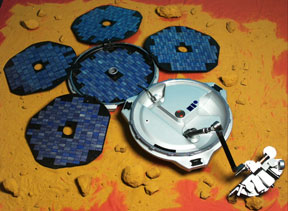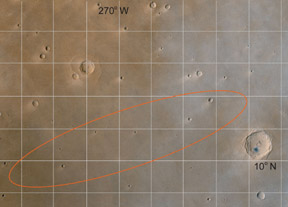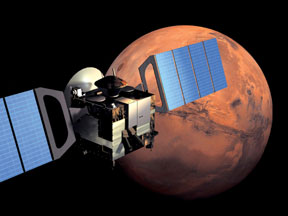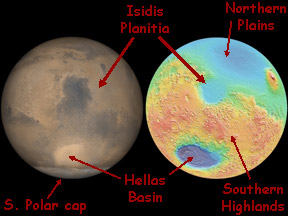Click on image for full size
Image courtesy European Space Agency (ESA)
Mars Express - Beagle 2 Lander
The European Space Agency (ESA) launched a mission to Mars called "Mars Express" in June of 2003. The Mars Express spacecraft has two parts: an orbiter that will circle the Red Planet for at least one Martian year (687 Earth days), and a lander named "Beagle 2" which is scheduled to touch down on the surface of the Mars on December 25, 2003.
Beagle 2 split off from the main Mars Express spacecraft on December 19, 2003. It has a heat shield to keep it from burning up as it enters the atmosphere of Mars. As it gets closer to the ground, parachutes will open to slow it down. Beagle 2 has airbags that will surround and protect it as it bounces to a stop on the surface of Mars. When it stops bouncing, the lander will unfold itself and get to work studying Mars. It has solar panels to supply it with energy during the daytime.
The Beagle 2 lander will try to find life on the surface of Mars. It has a robotic arm that will scoop up soil. It will find out what kinds of chemicals are in the soil. Some types of chemicals are mostly made by living creatures. If Beagle 2 finds those types of chemicals it will have strong evidence that it might have found life. Beagle 2 will land in a flat area called "Isidis Planitia" that is inside an old crater. There may have been a lake inside the crater many years ago.
Beagle 2 is named after a famous ship, the H.M.S. Beagle. A scientist named Charles Darwin sailed on the H.M.S. Beagle in the mid-1800s. Darwin was one of the first scientists to explain how evolution works. The theory of evolution is very important in the science of biology. If scientists find life on Mars with the Beagle 2, that would be a very important discovery for the science of biology, too. That is why the Mars Express mission planners decided to name their lander after Darwin's ship.














